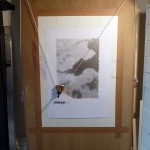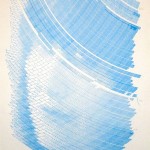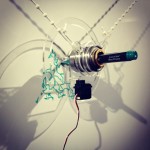Building a polargraph: project motivation and initial thoughts
As part of an graduate-level independent study course I am taking through my university’s Art department, I will creating a polargraph drawing machine and installing it in a public hallway for public viewing. The polargraph will hopefully be a short but sweet project meant to expose undergraduates, faculty and passer-bys to the artistic applications of technology that are available to them today. Furthermore, a series of articles on this blog will document the entire build process as it happens in order to help others re-create the effort, and hopefully encourage students to experiment with electronics and programming by removing some of the mystery about how these types of projects happen.
What is a polargraph?
 A polargraph is a type of drawing machine / pen plotter used to produce graphics on vertical surfaces using a system of pulleys, string and motors. A suspended carriage, referred to as a gondola, is suspended by string between two motors, which can pull the gondola in different directions, dragging a pen or other implement across the surface of the piece.
A polargraph is a type of drawing machine / pen plotter used to produce graphics on vertical surfaces using a system of pulleys, string and motors. A suspended carriage, referred to as a gondola, is suspended by string between two motors, which can pull the gondola in different directions, dragging a pen or other implement across the surface of the piece.
It is important to note that a polargraph is simply a type of drawing machine, which is something that artists have been exploring for decades. In many ways, the polargraph is nothing new, as it uses some of the same technological principles that your desktop printer uses!
Why build a polargraph?
Polargraphs are attractive, to me, for a variety of reasons: they require relatively few parts, can be made to cover large areas, and are very pleasing and thought-provoking to watch. While they can be built using very few components, the apparent simplicity hides a surprising amount of detail and care. For example, changes to very small characteristics of the polargraph system can have large consequences on the final output of the machine – not enough weight on the gondola may cause it to ‘bounce’ or jiggle too easily, making all the imagery appear jittery. To me, this aspect of the polargraph project presents a unique opportunity to serve as a fantastic learning opportunity for students.
The simplicity of the system can easily draw in prospective makers and hackers who would otherwise never have wanted to try to program or learn about electronics. Once they start playing, however, they can push themselves to pick up better and better skills just to try to make their polargraph just a little bit better, all the while gaining real experience with hardware and software that will have a big impact on their future activities and thoughts.
Related projects
- Polargraph Instructable: http://www.instructables.com/id/Polargraph-Drawing-Machine/
- Polargraph.co.uk: http://www.polargraph.co.uk/
- Der Kritzler: http://tinkerlog.com/2011/09/02/der-kritzler/
- Wallrus: http://rolocroz.com/wallrus/
- Hektor: http://hektor.ch/
- Online whiteboard: http://spritesmods.com/?art=whiteboard




